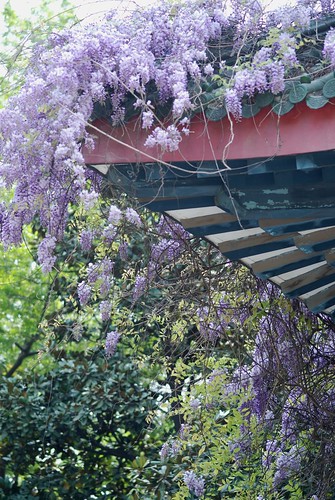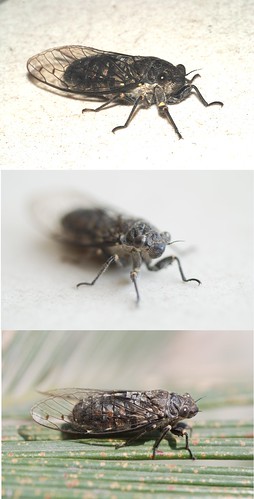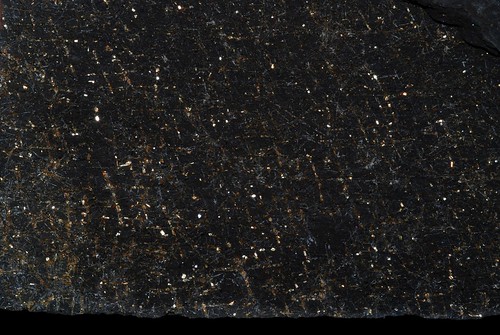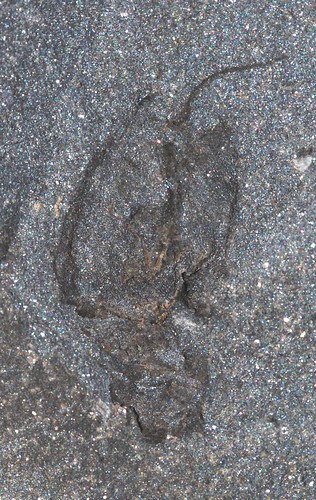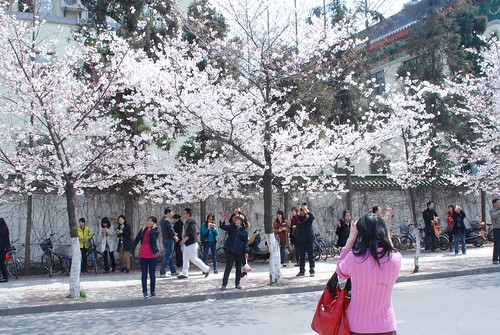Spring is here, and it's time to go out on fieldwork before the rainy season begins. So, we're off to Guizhou (South China), back on the 5th of May. Expect some tales of our exploits - those we're allowed to talk about!
Sunday 24 April 2011
Tuesday 19 April 2011
Photographing cicadas
Now then - an excuse to ramble about bugs, and also say a bit about insect photography. How could I resist?
The cicadas are just coming out in the warm weather here, and already are starting to make a real racket. They're gorgeous insects, about 2 cm up to at least 5 cm long, and closely related to greenfly and leafhoppers. There's maybe one species in the UK - a small, shy species that lived until recently in the New Forest. Alas, it may well now be extinct.
It's often hard to be sure with cicadas, though, because they have a multi-year life cycle. Some stay as nymphs for nearly twenty years, feeding on tree roots underground, and only emerging (often en masse) as an adult for a few brief weeks - at which point they promptly climb the highest tree they can find, and start scraping their legs against their wings. As a result, cicadas are much more commonly heard than seen. A traditional children's game in China is catching cicadas in the first weeks of summer, using a long pole with sticky stuff on the end. They then put them in cages, hang them outside their windows, and have competitions to see who can deafen the most neighbours with the fewest bugs. At least, that's the way it apparently used to be - we'll have to see if it happens this year.
This one took pity on me, and was waiting for us in the lobby of apartment block this morning. A small one, about 2 cm long, it was very friendly, and was delighted to cling onto my finger as I tried to transplant it to the cycads outside.
Taking photographs of insects can be a bit tricky if you don't know where to start, and you can get completely different results from different settings on you camera. These three pictures are taken with the same camera, minutes apart, and give you an idea of the different effects you can get from one that lets you fiddle with settings...
Top picture: flash, indoors, with subsequent processing of brightness and contrast. The colours are difficult to see, and many features are very "hard" - it's a very harsh lighting effect, although often essential if you're looking at tiny insects rather than things a couple of centimetres long, as here.
The middle photo was taken indoors in quite good ambient light. In order to get a sensible exposure time (to avoid camera shake), the aperture is wide open. The result is a very limited depth of field, hence all the blurring in the background (exacerbated by the oblique view of course!).
Finally, the last was taken outside, in strong sunlight, with no flash. The ambient light level was high enough to allow a part-closed aperture, hence a decent depth of field, and the colours are pretty much true. This is by far the preferred method if you're dealing with big things, and it's worth putting the ISO up a bit if necessary to get a manageable exposure time. Sadly, I normally do tiny things, where flash, glare and non-true colours start to become a problem.
Still, I'm sure there will plenty of bigger beasties to keep us occupied this year!
Spoils of something-or-other
Well, we survived the trip, and very successful it was too. We actually found enough for several papers, and are working hard on them even now (well, more or less - we have just had dinner, and we've got to be in early to use the electron microscope).
This one is a rather stunning specimen of Protospongia - or something very like it, but I think it really is Protospongia, unlike most of the species that have been called it in the past. The grid is made up of cross-shaped spicules, which would have been made of opal (probably, but that's another story) when alive. It was buried in quite unpleasant, anoxic mud, and the spicules have been replaced by pyrite (fools' gold). It's very common for spicules to be replaced like that; it's not at all common for the skeleton to be preserved beautifully intact. This is only a fragment, but the field of view is about 7 cm across. the complete sponge would have been a delicate, bowl-shaped thing with the wall consisting of a single layer of spicules, surrounded by soft tissue, the entire sponge probably a good half a metre in diameter.
Now, isn't that cute?
Monday 11 April 2011
Spongy paradise!
This is just a quick post to let you know we're off to collect more sponges. Rather than a flying visit, this will be four full days of spongiferousness, including the ecology, and collecting as much as we can of what is starting to look like the most diverse fossil sponge fauna on the planet.
You'll notice there's quite a lot of rock exposed. This is a Good Thing, and it's what we're almost invariably lacking in Wales. Beyond the annoyance factor of having to hack through brambles to find a bit of rock, it's got to severely bias the appearance of the fossil record as well. If we had the same rocks in Wales, how many species would we see? If we got a tenth of them, I'd be surprised.
Of course, that works the other way as well. One of the things we're finding in Wales is that a vast amount of really interesting stuff has just been overlooked. Sites with soft tissue preservation, or complete starfish, are not all that rare... you just have to be persistent. We're wondering how many of the sites of exceptional preservation in the world are only known due to being quarried for whatever reason. How many more are there out there? Would exceptional preservation really be all that exceptional if we had more sites like this?
For now, though, who cares? We've got sponges. For four days. That's quite a lot of them, with any luck...
Wednesday 6 April 2011
Weird fossils no. 1 (yes, I've lost count)
There are so many weird fossils to choose from, I hardly know where to start. If you want some inferior levels of weirdness, head over to Chris Nedin's blog on Ediacarans - but let's face it, anything you can make a doily out of hasn't yet dredged the depth of utter weirditude. Mitrates, on the other hand... now they're *really* weird.
I would start by telling you what they are, but that's really part of the problem. They've got a round-ish body (the top part), covered by some big plates and with a little movable spiky bit sticking out, and then a multi-plated dangly bit that is open to interpretation. That doesn't really tell you a lot. They're part of a wider group called carpoids, calcichordates or stylophorans, depending on personal whim. Few people call them calcichordates nowadays, though - that term presupposes a certain way of thinking that is somewhat controversial. The idea is that of Dick Jefferies, of the Natural History Museum in London, now retired and sadly rather ill. Simply put, his idea is that these and their even weirder cousins (cornutes, solutes, ctenocystoids and cinctans) are the ancestors of all the groups one of the major divisions of animal life. This group is the deuterostomes, and it includes us (chordates), echinoderms (starfish, sea urhcins, etc.) and an obscure (oops, sorry Lucy!) group called hemichordates (including the graptolites, as you well know). This mitrate would then be seen as effectively a tadpole-like creature with calcite armour plating.
The hypothesis that Jefferies worked on for 40 years was intricate and beguiling, and based on exquisitely fine interpretations of the details of the fossils. Over the past ten or twenty years, however, his views have gradually lost popularity, as a result of a wide range of developments in a number of fields, and they are now believed to be a type of echinoderm.
We have long known that they're close to echinoderms. First, that skeleton that's preserved here as a mould has a structure called stereom - a honeycomb texture that is unique to echinoderms. The way the skeleton is put together, in a series of plates, is also characteristic. In fact, it really does look like an echinoderm... except it hasn't got any symmetry. That's right - none. Starfish have five arms, as you know. Most animals have (more-or-less) one mirror plane of symmetry. Carpoids don't, and that's weird.
They're not alone in their weirdness, though - there are many truly bizarre groups of extinct early echinoderms, like the helicoplacoids, blastoids, edrioasteroids, and so forth - a whole menagerie of strane symmetries and stranger structures. Although we're now pretty sure that carpoids fit in the echinoderm tree, we still don't know where to stick the branch. Some would argue the bit at the bottom of the photo is basically a stalk (and some species seem to have attached by, it dragged themselves over the sea floor with it). Others would argue it is a feeding arm (recent finds show that it had plates that opened over a groove, very like as in sea lilies). Some argue that the different groups of carpoids are entirely separate branches that have evolved independently...
We do know they're very old, extinct, and very rare. Actually, scratch that last point - we think they're just overlooked. The beastie in the picture is about 5 mm long, and that's a complete one. They're only rarely preserved complete, because they need to be buried in one go for the delicate skeleton to have any chance of survival. The individual plates, at a millimetre or so across, are easily missed. In other words, these are only "bizarre" because we hardly ever see them. But that's no fault of theirs... they were perfectly decent results of evolution. The problem is more that palaeontologists often don't look hard enough. Sometimes it makes you question our ideas about the entire fossil record... how much is sitting there, completely overlooked?
So go on - next time you're out on the hills, turn over one more rock and be prepared to squint properly.
Friday 1 April 2011
cherry blossom viewing
Spring has definitely arrived here; you can tell because lots of people are out looking at the cherry blossom. These trees line the street outside the institute, and every time we come in or go out there are crowds of people taking photos.
Another sign of spring is the profusion of tropical fruit: yesterday we had mango at breakfast, pineapple at lunch and longans in the evening. The watermelon, jackfruit and rambutans are also delicious, although the lychee season hasn't started yet. We don't have names for some of the other fruit, but they are also very nice. Haven't tried durian yet, though.
Chris: I'll make use of your comments if I ever knit another dickinsoniid!

